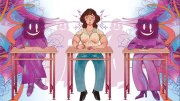The 1890 U.S. census asked blacks to identify their status as "mulattoes," "quadroons," or "octoroons." Such categories have been used historically to discriminate against particular groupsthe number of "quadroons" and "octoroons," for example, could be used to support the argument that intermarriage degraded both white and black stock and hence was bad for both races. Today, however, many minorities believe that a separate census tally works to their advantage for congressional redistricting and affirmative action. Thus, even though the archaic, pseudoscientific language is gone from the census forms, racial categorizations still loom large in the census.
The eight-question short form of the 2000 census, sent to all households, offered as racial options "White," "Black, African-Am., or Negro," "American Indian or Alaska Native," or one of 11 separate Asian or Pacific Island groups. Another question asked if respondents were "Spanish/Hispanic/Latino" and if so, to sort themselves as "Mexican, Mexican Am., Chicano," Puerto Rican, Cuban, or other.
Professor of education and sociology emeritus Nathan Glazer terms the amount of space devoted to race and Hispanicity on the census short form "ridiculous." Last fall, in The Public Interest, Glazer declared that the census form was "miseducating" the American people about the importance of race. In the census, he says, race and ethnicity "appear to be more important than how educated Americans are, whether they are foreign-born, or whether they voted in the last election."
Only blacks should be able to identify themselves by race, according to Glazer; he explains that, unlike other minorities, African Americans did not come to this country by choice and historically have intermarried less than other groups. He recommends a second question asking for the birthplaces of respondents, their parents, and perhaps their grandparentsand that would be it for the category of race. Glazer argues that the United States is, and should be, a melting pot that assimilates immigrant groups, so that by the third generation, intermarriage and social mobility will render one's race largely symbolic.
The current elaborate race questions, he contends, reflect political lobbying by the various ethnic groups themselves. In 1970, for example, President Nixon bowed to pressure from the U.S. Interagency Committee on Mexican-American Affairs and ordered the "Hispanic" category added to the census formwhich was already at the printer's. Immigrants from India, he says, were initially classified as white, but Indian leaders pushed to be identified as Asian, thinking this would bring affirmative-action benefits.
"There's a lot of illusion there," Glazer explains. "There's the notion that the more of you there are, in some way, it's going to be better for you. Either you'll get more distribution from the federal governmentwhich doesn't really work out that wayor politicians will take you more seriously. So ethnic groups tend to inflate their numbers. The fact is, there is no distribution of federal funds on the basis of ethnic-group size."
~ Robin Abrahams
Nathan Glazer e-mail address: nglazer@fas.harvard.edu





